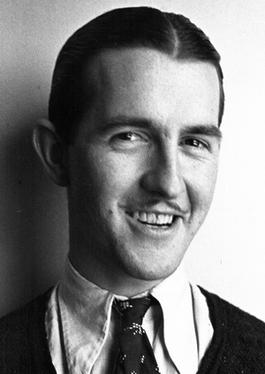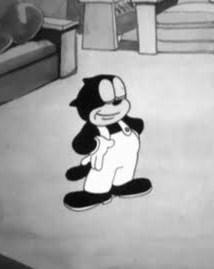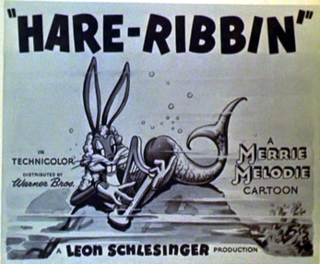
Looney Tunes is an American animated comedy short film series produced and distributed by Warner Bros. The series originally ran from 1930 to 1969, concurrently with its partner series Merrie Melodies, during the golden age of American animation. Following a revival in the late 1970s, new shorts were released as recently as 2014. The two series introduced a large cast of characters, including Bugs Bunny, Daffy Duck, and Porky Pig. The term Looney Tunes has since been expanded to also refer to the characters themselves.

Isadore "Friz" Freleng, credited as I. Freleng early in his career, was an American animator, cartoonist, director, producer, and composer known for his work at Warner Bros. Cartoons on the Looney Tunes and Merrie Melodies series of cartoons. In total he created more than 300 cartoons.

Robert Porter McKimson Sr. was an American animator and illustrator, best known for his work on the Looney Tunes and Merrie Melodies series of cartoons from Warner Bros. Cartoons and later DePatie–Freleng Enterprises. He wrote and directed many animated cartoon shorts starring Bugs Bunny, Daffy Duck, Porky Pig, Foghorn Leghorn, Hippety Hopper, Speedy Gonzales, and the Tasmanian Devil, among other characters. He also developed Bugs Bunny's design in the 1943 short Tortoise Wins by a Hare.
Charlie Dog is an animated cartoon character in the Warner Brothers Looney Tunes series of cartoons. The character was featured in nine cartoons between 1941 and 1958. He is generally characterized as a friendly wise guy.

Merrie Melodies is an American animated comedy short film series distributed by Warner Bros. It is the companion series to Looney Tunes, and featured many of the same characters as the former series. It originally ran from August 2, 1931 to September 20, 1969, during the golden age of American animation, though it had been revived in 1979, with new shorts sporadically released until June 13, 1997. Originally, Merrie Melodies placed emphasis on one-shot color films in comparison to the black and white Looney Tunes films. After Bugs Bunny became the breakout character of Merrie Melodies and Looney Tunes transitioned to color production in the early 1940s, the two series gradually lost their distinctions and shorts were assigned to each series randomly.

Beans the Cat is an animated cartoon character in the Warner Bros. Cartoons series of cartoons from 1935–1936. Beans was the third Warner Bros cartoon character star after Bosko and Buddy. He is voiced by Billy Bletcher and occasionally by Tommy Bond. He was created by director Friz Freleng. The character was featured in nine cartoons made in 1935 and 1936.

Life with Feathers is a 1945 Warner Bros. Merrie Melodies animated short film directed by Friz Freleng. The short was released on March 24, 1945, and is the first cartoon to feature Sylvester the Cat.

I Haven't Got a Hat is a 1935 animated short film, directed by Isadore Freleng for Leon Schlesinger Productions as part of the Merrie Melodies series. Released on March 2, 1935, the short is notable for featuring the first appearance of several Warner Bros. cartoon characters, most notably future cartoon star Porky Pig. Beans the Cat, a minor Looney Tunes star in 1935-1936, also made his first appearance in this cartoon.
Warner Bros. Cartoons, Inc. was an American animation studio, serving as the in-house animation division of Warner Bros. during the Golden Age of American animation. One of the most successful animation studios in American media history, it was primarily responsible for the Looney Tunes and Merrie Melodies series of animated short films. The characters featured in these cartoons, including Bugs Bunny, Daffy Duck, and Porky Pig, are among the most famous and recognizable characters in the world. Many of the creative staff members at the studio, including directors and animators such as Chuck Jones, Friz Freleng, Robert McKimson, Tex Avery, Robert Clampett, Arthur Davis, and Frank Tashlin, are considered major figures in the art and history of traditional animation.

Cool Cat is a fictional cartoon character created by director Alex Lovy for Warner Bros.-Seven Arts Animation. He was the final star of the original Warner Bros. theatrical cartoons. His first appearance was in an eponymous short in 1967. He was voiced by Larry Storch. Robert McKimson took over as director for the last two cartoons in this series.

Birds Anonymous is a 1957 Warner Bros. Merrie Melodies animated short, directed by Friz Freleng and written by Warren Foster. The short was released on August 10, 1957, and stars Tweety and Sylvester.

Tale of Two Mice is a 1945 Warner Bros. cartoon in the Looney Tunes series, directed by a uncredited Frank Tashlin. It is a sequel to 1942's A Tale of Two Kitties, with the Abbott and Costello characterizations now cast as mice. They are voiced by Tedd Pierce and Mel Blanc respectively.

Hare Ribbin' is a 1944 animated short film in the Merrie Melodies series, directed by Robert Clampett and featuring Bugs Bunny. The plot features Bugs' conflict with a red-haired hound dog, whom the rabbit sets out to evade and make a fool of using one-liners, reverse psychology, disguises and other tricks. It was released in theaters by Warner Bros. on June 24, 1944. The title is a pun on "hair ribbon".
The Stupid Cupid is a 1944 Warner Bros. Looney Tunes animated cartoon directed by Frank Tashlin. The cartoon was released on November 25, 1944, and stars Daffy Duck and Elmer Fudd.
Wagon Heels is a 1945 Warner Bros. Merrie Melodies short directed by Bob Clampett. The short was released on July 28, 1945, and stars Porky Pig.
This is a listing of all the animated shorts released by Warner Bros. under the Looney Tunes and Merrie Melodies banners between 1940 and 1949.
This is a listing of all the animated shorts released by Warner Bros. under the Looney Tunes and Merrie Melodies banners between 1960 and 1969. A total of 147 shorts were released during the 1960s.

Bugged by a Bee is a 1969 Warner Bros. Looney Tunes animated cartoon directed by Robert McKimson. It starred Cool Cat, and was the final cartoon from the original Looney Tunes/Merrie Melodies series to bear the Looney Tunes name, and the last from that era to be widely released. One more cartoon, Injun Trouble, would follow Bugged by a Bee, but it was in the Merrie Melodies series.
The Miller's Daughter is a 1934 Warner Bros. Merrie Melodies cartoon directed by Friz Freleng. The short was released on October 13, 1934.












